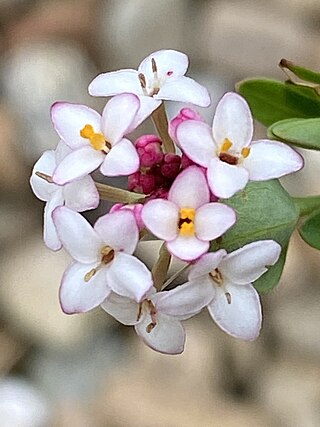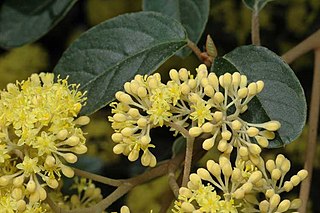
Utricularia dichotoma, commonly known as fairy aprons, is a variable, perennial species of terrestrial bladderwort. It is a widespread species with mauve or purple fan-shaped flowers on a slender stalk and usually grows in wet locations.

Pimelea spicata, commonly known as the spiked rice flower, is a flowering plant in the family Thymelaeaceae and is endemic to New South Wales. It is a slender plant with white flowers and elliptic leaves.

Lobelia purpurascens, commonly known as white root or purplish pratia, is a flowering plant in the family Campanulaceae of eastern Australia. It is a small herbaceous, scrambling plant with white to pale pink flowers.

Comesperma volubile, commonly known as love creeper, is a slender climber in the family Polygalaceae. It is a twining plant with linear leaves and pea-like blue flowers.

Pultenaea juniperina, commonly known as prickly bush-pea or prickly beauty is a species of flowering plant in the family Fabaceae and is endemic to south-eastern Australia. It is an erect, spiky shrub with hairy stems, linear to narrow elliptic leaves with stipules at the base, and yellow-orange and red flowers.

Persoonia juniperina, commonly known as prickly geebung, is a species of flowering plant in the family Proteaceae and is endemic to south-eastern Australia. It is a small erect to low-lying shrub with smooth bark, hairy new branches, linear leaves, yellow flowers borne singly or in groups of up to forty in leaf axils, and yellowish green to purplish fruit.

Stackhousia monogyna, commonly known as creamy stackhousia or creamy candles,is a flowering plant in the family Celastraceae. It is a small multi-stemmed plant with narrow leaves and terminal spikes of white, cream or yellow flowers. It is a widespread species found in all states of Australia but not the Northern Territory.

Pimelea ferruginea, commonly known as pink rice flower or coastal banjine, is a species of flowering plant in the family Thymelaeaceae and is endemic to near-coastal areas of south-western Western Australia. It is a dense, erect shrub with elliptic to narrowly elliptic leaves and head-like clusters of pale to deep pink, tube-shaped flowers.

Pomaderris elliptica, commonly known as yellow dogwood or smooth pomaderris, is a species of flowering plant in the family Rhamnaceae and is endemic to south-eastern Australia. It is a shrub with densely hairy branchlets, egg-shaped or elliptic leaves, and pale yellow flowerss.

Pimelea ligustrina is a species of flowering plant in the family Thymelaeaceae, and is endemic to south-eastern Australia. It is a shrub with lance-shaped or narrowly elliptic leaves arranged in opposite pairs, and clusters of creamy-white, white or pinkish flowers usually surrounded by 4 or 8, greenish to reddish brown involucral bracts.

Olearia myrsinoides, commonly known as silky daisy-bush or blush daisy bush, is a species of flowering plant in the family Asteraceae and is endemic to south-eastern Australia. It is a spreading shrub with hairy branchlets, egg-shaped to elliptic leaves with toothed edges, and white and yellow or mauve, daisy-like inflorescences.

Pimelea drupacea, commonly known as cherry rice-flower, is a species of flowering plant in the family Thymelaeaceae and is endemic to south-eastern Australia. It is a shrub with elliptic leaves arranged in opposite pairs, and head-like clusters of white, tube-shaped flowers surrounded by two or four leaves.

Pimelea nivea is a species of flowering plant in the family Thymelaeaceae and is endemic to Tasmania. It is an erect shrub with densely hairy young stems, elliptic to round leaves arranged in opposite pairs, and compact clusters of white or cream-coloured flowers.

Epacris sparsa, is a small upright shrub with creamy-white flowers, elliptic to egg-shaped leaves and reddish new growth. It is endemic to New South Wales with a restricted distribution.

Goodenia elongata, commonly known as lanky goodenia, is a species of flowering plant in the family Goodeniaceae and is endemic to south-eastern Australia. It is an erect or ascending herb with lance-shaped stem leaves, and yellow flowers arranged singly or in racemes.

Leucopogon muticus, commonly knwon as blunt beard-heath, is a species of flowering plant in the heath family Ericaceae and is endemic to eastern Australia. It is an erect, straggling shrub with egg-shaped leaves with the narrower end towards the base, and small numbers of white, tube-shaped flowers that are densely bearded inside.

Pultenaea dentata, commonly known as clustered bush-pea, is a species of flowering plant in the family Fabaceae and is endemic to south-eastern Australia. It is an erect to low-lying or prostrate, open shrub with elliptic to narrow egg-shaped leaves and dense clusters of yellow, red and purple flowers.

Leucopogon collinus, commonly known as fringed beard-heath, is a species of flowering plant in the heath family Ericaceae and is endemic to south-eastern Australia. It is a slender, erect or spreading shrub with narrowly lance-shaped leaves, and white, tube-shaped, bearded flowers.
Pimelea clavata is a species of flowering plant in the family Thymelaeaceae and is endemic to near-coastal areas and offshore islands of southern Western Australia. It is an erect shrub with narrowly elliptic to more or less linear leaves arranged in opposite pairs, and head-like clusters of white to pale yellow, tube-shaped flowers surrounded by leaf-like involucral bracts.

Comesperma retusum, commonly known as milkwort, is a slender herb in the family Polygalaceae. It is an upright shrub with purple or mauve-pink pea-like flowers and grows in eastern Australia.




















